Decoding the Street-Based Spatiality of Urban Gyms: Implications for Healthy City Planning
Abstract
1. Introduction
2. Methodology
2.1. Study Site
2.2. Data Sources
2.3. Methods
2.3.1. Network-Based Kernel Density Estimation (Net-KDE)
2.3.2. Segment Street-Based Analysis
2.3.3. Natural Street-Based Analysis
3. Results
3.1. Spatial Statistics of Gyms
3.2. Gym Spatiality Characterized by Segment Street
3.2.1. Spatial Pattern of Gyms Based on Net-KDE
3.2.2. The Walkable Accessibility of Gyms by Segment-Based Network Analysis
3.3. Gym Spatiality Characterized by Natural Street
4. Discussion
4.1. Research Findings
4.2. Research Strengths and Limitations
4.2.1. Strengths
4.2.2. Limitations
4.2.3. Policy Implications
5. Conclusions
Author Contributions
Funding
Institutional Review Board Statement
Informed Consent Statement
Data Availability Statement
Conflicts of Interest
References
- Ewing, R.; Cervero, R. Travel and the built environment: A meta-analysis. J. Am. Plan. Assoc. 2010, 76, 265–294. [Google Scholar] [CrossRef]
- Giles-Corti, B.; Vernez Moudon, A.; Reis, R.; Turrell, G.; Dannenberg, A.L.; Badland, H.; Foster, S.; Lowe, M.; Sallis, J.F. City planning and population health: A global challenge. Lancet 2016, 388, 2912–2924. [Google Scholar] [CrossRef]
- Woodcock, J.; Edwards, P.; Tonne, C.; Armstrong, B.G.; Ashiru, O.; Banister, D.; Beevers, S.; Chalabi, Z.; Chowdhury, Z.; Cohen, A.; et al. Public health benefits of strategies to reduce greenhouse emissions: Urban land transport. Lancet 2009, 374, 1930–1943. [Google Scholar] [CrossRef]
- Roberts, I.; Edwards, P. The Energy Glut: The Politics of Fatness in an Overheating World; Zed Books Limited: London, UK, 2010. [Google Scholar]
- Sallis, J.; Spoon, C.; Cavill, N.; Engelberg, J.K.; Gebel, K.; Parker, M.; Thornton, C.M.; Lou, D.; Wilson, A.L.; Cutter, C.L.; et al. Co-benefits of designing communities for active living: An exploration of literature. Int. J. Behav. Nutr. Phys. Act. 2015, 12. [Google Scholar] [CrossRef]
- Sallis, J.; Bull, F.; Burdett, R.; Frank, L.D.; Griffiths, P.; Giles-Corti, B.; Stevenson, M. Use of science to guide city planning policy and practice: How to achieve healthy and sustainable future cities. Lancet 2016, 388, 2936–2947. [Google Scholar] [CrossRef]
- Khan, K.M.; Thompson, A.M.; Blair, S.N.; Sallis, J.F.; Powell, K.E.; Bull, F.C.; Bauman, A.E. Sport and exercise as contributors to the health of nations. Lancet 2012, 380, 59–64. [Google Scholar] [CrossRef]
- Stenner, B.J.; Buckley, J.D.; Mosewich, A.D. Reasons why older adults play sport: A systematic review. J. Sport Health Sci. 2020, 9, 530–541. [Google Scholar] [CrossRef]
- World Health Organization. Global Recommendations on Physical Activity for Health; 65 Years and Above; World Health Organization: Geneva, Switzerland, 2011. [Google Scholar]
- China State Council. China’s New National Fitness Plan and Opportunities in the Sports Industry (2016–2020); China State Council: Briefing, China, 2016. [Google Scholar]
- Isoaholo, S.E.; Weissinger, E. Leisure and well-being: Is there a connection? Aust. Parks Recreat. 1984, 19, 40–44. [Google Scholar]
- Kania, A. Hospital-health and fitness centers promote wellness. Health Care Strateg. Manag. 1993, 11, 18–23. [Google Scholar]
- Ravenscroft, N. The vitality and viability of town centers. Urban. Stud. 2000, 37, 2533–2549. [Google Scholar] [CrossRef]
- Peters, K.B.M. Leisure in Public Spaces: Does It Contribute to Social Cohesion in Dutch Neighborhoods; ISA World Congress of Sociology, International Sociological Association: Gothenburg, Sweden, 2010. [Google Scholar]
- King, H.; Gierisch, J.; Williams, J.W., Jr.; Maciejewski, M.L. Effects Of Health Plan-Sponsored Fitness Center Benefits On Physical Activity, Health Outcomes, And Health Care Costs And Utilization: A Systematic Review; Department of Veterans Affairs: Washington, DC, USA, 2012. [Google Scholar]
- Schwab, K.; Dustin, D. Just Leisure: Things that We Believe in; Sagamore: Urbana, IL, USA, 2013. [Google Scholar]
- Floyd, M.E. Social justice as an integrating force for leisure research. Leis. Sci. 2014, 36, 379–387. [Google Scholar] [CrossRef]
- Liu, Y.L.; Jing, Y.; Cai, E.; Cui, J.; Zhang, Y.; Chen, Y. How leisure venues are and why? A geospatial perspective in Wuhan, Central China. Sustainability 2017, 9, 1865. [Google Scholar] [CrossRef]
- Jing, Y.; Liu, Y.; Cai, E.; Liu, Y.; Zhang, Y. Quantifying the spatiality of urban leisure venues in Wuhan, Central China—GIS-based spatial pattern metrics. Sustain. Cities Soc. 2018, 40, 638–647. [Google Scholar] [CrossRef]
- Shrestha, S.; Kestens, Y.; Thomas, F.; El Aarbaoui, T.; Chaix, B. Spatial access to sport facilities from the multiple places visited and sport practice: Assessing and correcting biases related to selective daily mobility. Soc. Sci. Med. 2019, 236, 112406. [Google Scholar] [CrossRef]
- Higgs, G.; Langford, M.; Norman, P. Accessibility to sport facilities in Wales: A GIS-based analysis of socio-economic variations in provision. Geoforum 2015, 62, 105–120. [Google Scholar] [CrossRef]
- Boone-Heinonen, J.; Popkin, B.M.; Song, Y.; Gordon-Larsen, P. What neighborhood area captures built environment features related to adolescent physical activity? Health Place 2010, 16, 1280–1286. [Google Scholar] [CrossRef]
- Karusisi, N.; Thomas, F.; Méline, J.; Chaix, B. Spatial accessibility to specific sport facilities and corresponding sport practice: The Record Study. Int. J. Behav. Nutr. Phys. Act. 2013, 48, 1–10. [Google Scholar] [CrossRef]
- Cutumisu, N.; Spence, J. Sport Fields as Potential Catalysts for Physical Activity in the Neighborhood. Int. J. Environ. Res. Public Health 2012, 9, 294–314. [Google Scholar] [CrossRef]
- Ogilvie, D.; Lamb, K.E.; Ferguson, N.S.; Ellaway, A. Recreational physical activity facilities within walking and cycling distance: Sociospatial patterning of access in Scotland. Health Place 2011, 17, 1015–1022. [Google Scholar] [CrossRef]
- Lamb, K.E.; Ferguson, N.S.; Wang, Y.; Ogilvie, D.; Ellaway, A. Distribution of physical activity facilities in Scotland by small area measures of deprivation and urbanicity. Int. J. Behav. Nutr. Phys. Act. 2010, 7, 76. [Google Scholar] [CrossRef]
- Jiang, B.; Zhao, S.; Yin, J. Self-organized natural roads for predicting traffic flow: A sensitivity study. J. Stat. Mech. Theory Exp. 2008, 2008, P07008. [Google Scholar] [CrossRef]
- Ma, D.; Osaragi, T.; Oki, T.; Jiang, B. Exploring the heterogeneity of human urban movements using geo-tagged tweets. Int. J. Geogr. Inf. Sci. 2020, 34, 2475–2496. [Google Scholar] [CrossRef]
- Ma, D.; Omer, I.; Osaragi, T.; Sandberg, M.; Jiang, B. Why topology matters in predicting human activities. Environ. Plan. B Urban Anal. City Sci. 2018, 46, 1–17. [Google Scholar] [CrossRef]
- Tu, W.; Liu, Q. Illustrating the History of Wuhan; Wuhan Press: Wuhan, China, 2010. [Google Scholar]
- Okabe, S.; Satoh, T.; Sugihara, K. A kernel density estimation method for networks, its computational method and a GIS-based tool. Int. J. Geogr. Inf. Sci. 2009, 23, 1365–8816. [Google Scholar] [CrossRef]
- Ni, J.; Qian, T.; Xi, C.; Rui, Y.; Wang, J. Spatial distribution characteristics of healthcare facilities in Nanjing: Network point pattern analysis and correlation analysis. Int. J. Environ. Res. Public Health 2016, 13, 833. [Google Scholar] [CrossRef]
- Levine, N. CrimeStat III: A Spatial Statistics Program for the Analysis of Crime Incident Locations; Ned Levine & Associates: Houston, TX, USA, 2004. [Google Scholar]
- Xie, Z.; Yan, J. Kernel density estimation of traffic accidents in a network space. Comput. Environ. Urban. Syst. 2008, 32, 396–406. [Google Scholar] [CrossRef]
- Millward, H.; Spinney, J.; Scott, D. Active-transport walking behavior: Destinations, durations, distances. J. Transport. Geogr. 2013, 28, 101–110. [Google Scholar] [CrossRef]
- Clauset, A.; Shalizi, C.R.; Newman, M.E.J. Power-law distributions in empirical data. SIAM Rev. 2009, 51, 661–703. [Google Scholar] [CrossRef]
- Bettencourt, L.; Lobo, J.; Helbing, D.; Kühnert, C.; West, G.B. Growth, innovation, scaling and the pace of life in cities. Proc. Natl. Acad. Sci. USA 2007, 104, 7301. [Google Scholar] [CrossRef]
- Batty, M. The size, scale, and shape of cities. Science 2008, 319, 769. [Google Scholar] [CrossRef]
- Bettencourt, L. The origins of scaling in cities. Science 2013, 340, 1438. [Google Scholar] [CrossRef] [PubMed]
- Pate, R.R.; Mclver, K.; Colabianchi, N.; Troiano, R.P.; Reis, J.P.; Carroll, D.D.; Fulton, J.E. Physical Activity Measures in the Healthy Communities Study. Am. J. Pre Med. 2015, 49, 653–659. [Google Scholar] [CrossRef][Green Version]
- Silva, M.; Cashman, S.; Kunte, P.; Candib, L.M. Improving Population Health Through Integration of Primary Care and Public Health: Providing Access to Physical Activity for Community Health Center Patients. Am. J. Public Health 2012, 102, e56–e61. [Google Scholar] [CrossRef] [PubMed]
- Merie, A. The healthiest people in the world don’t go to the gym. Quartz Blue Zones. 7 November 2018. Available online: https://qz.com/quartzy/1452630/the-healthiest-people-in-the-world-dont-go-to-the-gym/ (accessed on 12 January 2021).
- Wannamethee, S.G.; Shaper, A.G. Physical activity in the prevention of cardiovascular disease: An epidemiological perspective. Sports Med. 2001, 31, 101–114. [Google Scholar] [CrossRef]
- Warburton, D.E.; Nicol, C.W.; Bredin, S.S. Health benefits of physical activity: The evidence. CMAJ 2006, 174, 801–809. [Google Scholar] [CrossRef]
- Beenackes, M.A.; Kamphuis, C.B.; Burdorf, A.; Mackenbach, J.P.; van Lenthe, F.J. Sports participation, perceived neighborhood safety, and individual cognitions: How do they interact? Int. J. Behav. Nutr. Phys. Act. 2011, 8, 76. [Google Scholar] [CrossRef]
- Kamphuis, C.B.; Van Lenthe, F.J.; Giskes, K.; Huisman, M.; Brug, J.; Mackenbach, J.P. Socioeconomic status, environmental and individual factors, and sports participation. Med. Sci. Sports Exerc. 2008, 40, 71–81. [Google Scholar] [CrossRef]
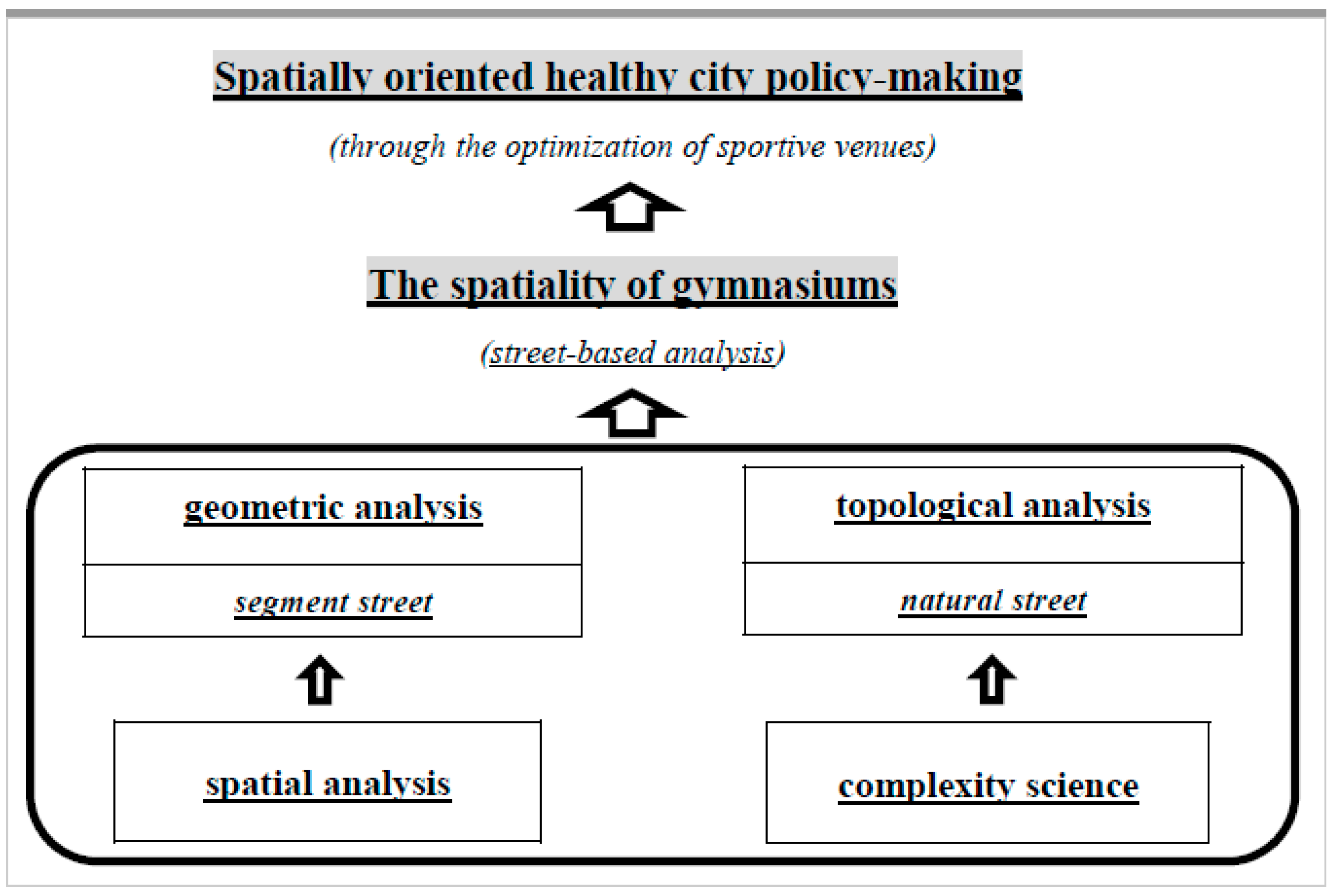




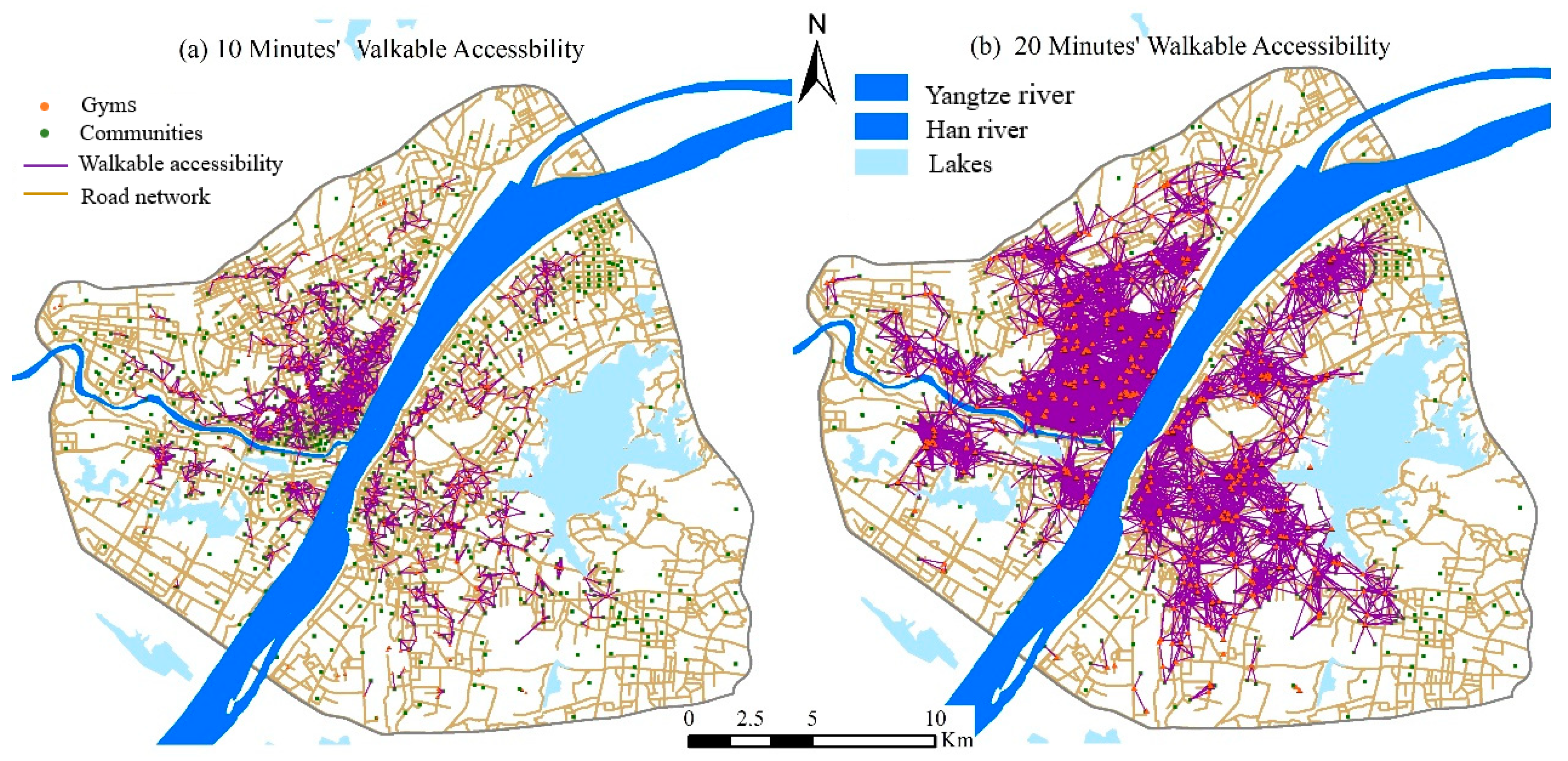
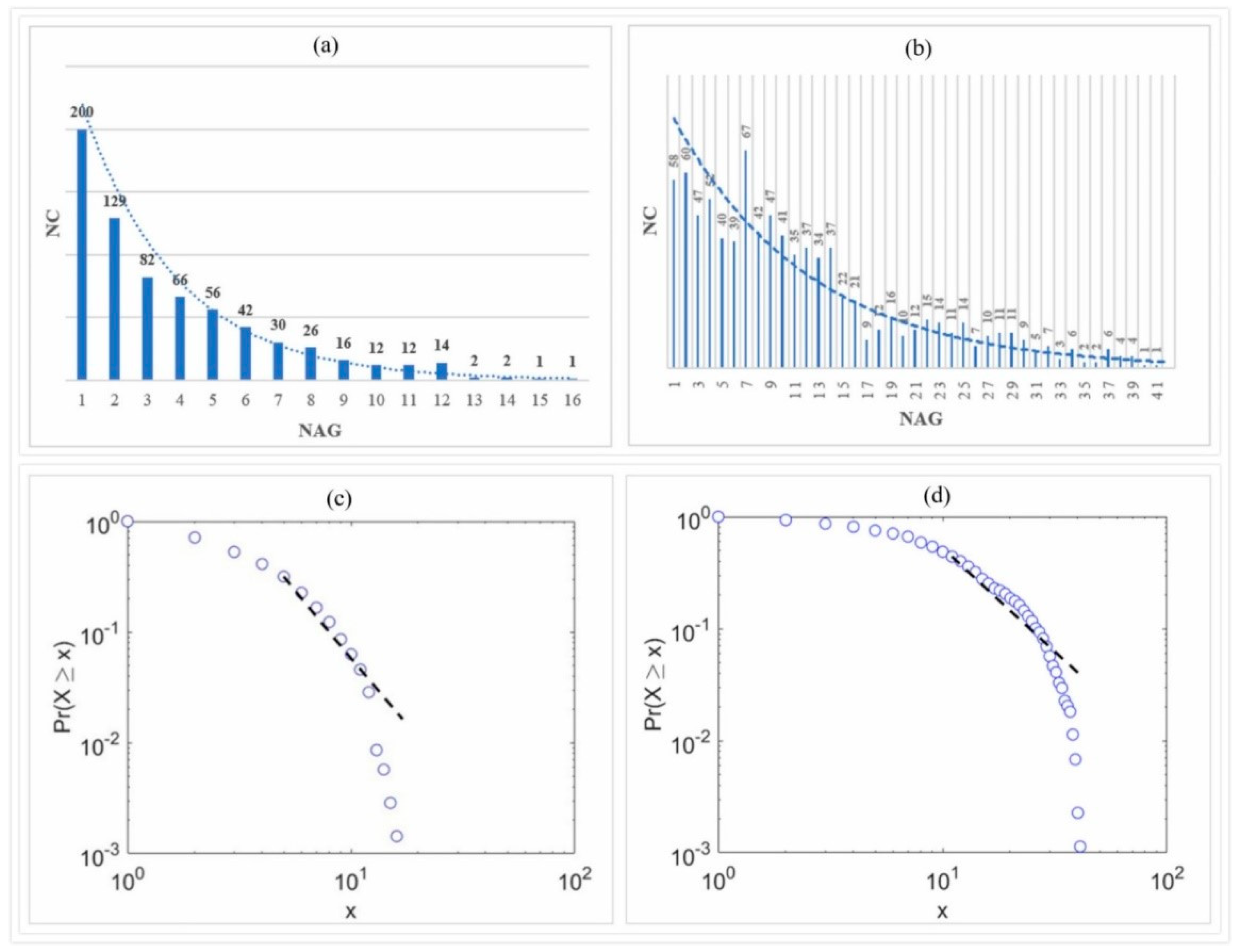
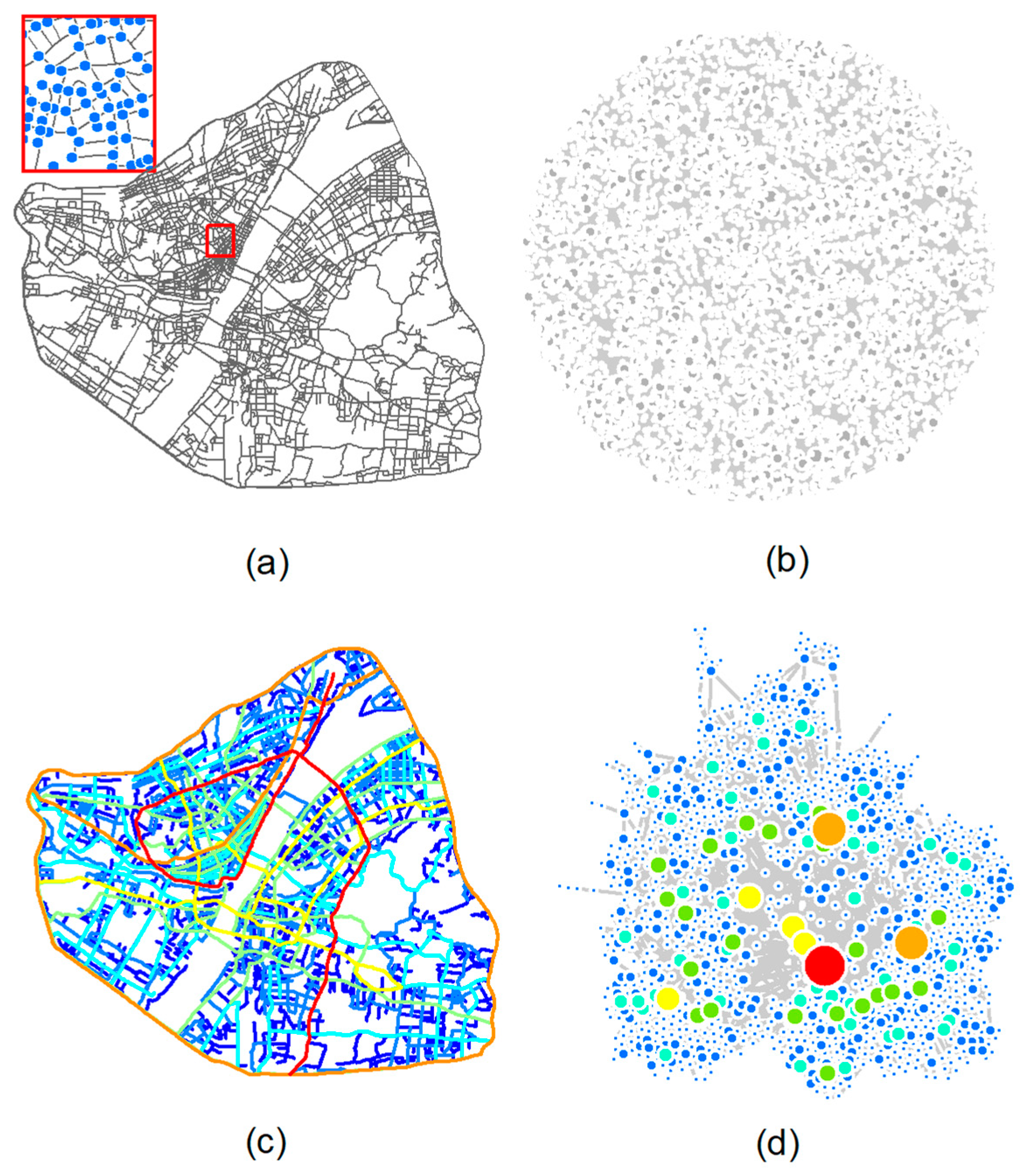
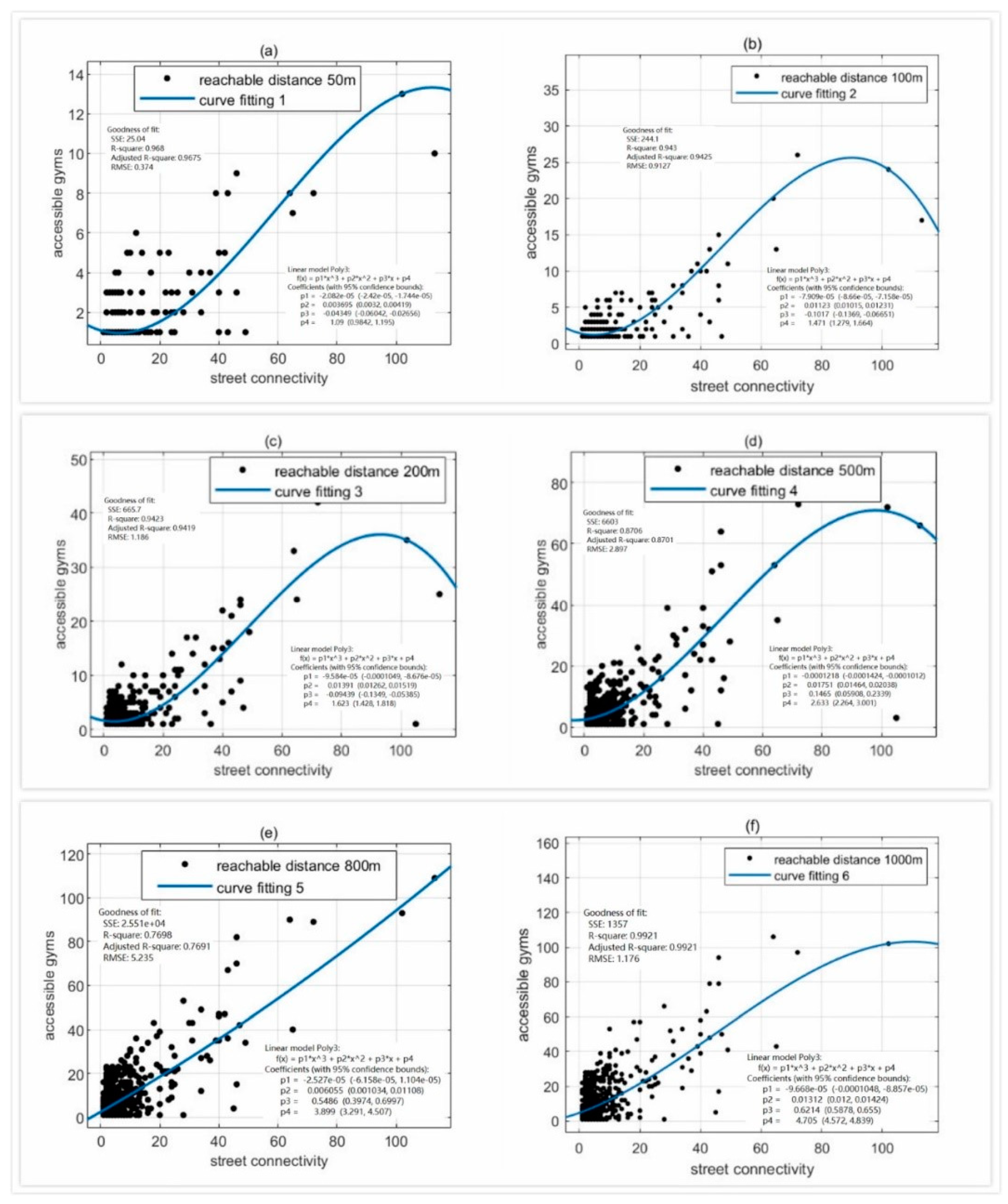
| Township | District | Area (km2) | Population | Population Density | Gym | Gym Density | Community |
|---|---|---|---|---|---|---|---|
| Wuchang | Wuchang | 64.5 | 911,721 | 14,135 | 122 | 1.89 | 169 |
| Qingshan | 15.0 | 109,320 | 7288 | 12 | 0.8 | 50 | |
| Hongshan | 203 | 607,393 | 2992 | 82 | 0.40 | 211 | |
| Hankou | Qiaokou | 38.37 | 693,538 | 18,075 | 41 | 1.07 | 140 |
| Jianghan | 27.99 | 589,104 | 21,047 | 76 | 2.72 | 121 | |
| Jiang’an | 73.60 | 1,049,120 | 14,254 | 92 | 1.25 | 187 | |
| Hanyang | Hanyang | 78.32 | 432,733 | 5525 | 46 | 0.59 | 125 |
| Clusters | Net-KDE Ranks | Township | Main Stem | Metro | Placemark |
|---|---|---|---|---|---|
| 1 | 1–5 | Hankou | Zhongshan Avenue Yangtze River Tunnel | the cross of No.1 & No.2 | Jianghan Commercial Pedestrian Street Hubei Provincial Department of Commerce |
| 2 | 2–5 | Wuchang | Zhongnan Road | the cross of No.2 & No.4 | Hongshan Commercial Square |
| 3 | 3–5 | Wuchang | Xudong Street | No.4 | Xudong Commercial Street |
| 4 | 4–5 | Hanyang | 2nd Road Loop | No. 4 | Wangjiawan Commercial Center |
Publisher’s Note: MDPI stays neutral with regard to jurisdictional claims in published maps and institutional affiliations. |
© 2021 by the authors. Licensee MDPI, Basel, Switzerland. This article is an open access article distributed under the terms and conditions of the Creative Commons Attribution (CC BY) license (http://creativecommons.org/licenses/by/4.0/).
Share and Cite
Jing, Y.; Ma, D.; Liu, Y.; Cui, J.; Zhang, S.; Chen, Y. Decoding the Street-Based Spatiality of Urban Gyms: Implications for Healthy City Planning. Land 2021, 10, 175. https://doi.org/10.3390/land10020175
Jing Y, Ma D, Liu Y, Cui J, Zhang S, Chen Y. Decoding the Street-Based Spatiality of Urban Gyms: Implications for Healthy City Planning. Land. 2021; 10(2):175. https://doi.org/10.3390/land10020175
Chicago/Turabian StyleJing, Ying, Ding Ma, Yaolin Liu, Jiaxing Cui, Sheng Zhang, and Yiyun Chen. 2021. "Decoding the Street-Based Spatiality of Urban Gyms: Implications for Healthy City Planning" Land 10, no. 2: 175. https://doi.org/10.3390/land10020175
APA StyleJing, Y., Ma, D., Liu, Y., Cui, J., Zhang, S., & Chen, Y. (2021). Decoding the Street-Based Spatiality of Urban Gyms: Implications for Healthy City Planning. Land, 10(2), 175. https://doi.org/10.3390/land10020175








